Physical Address
304 North Cardinal St.
Dorchester Center, MA 02124
Cerebrospinal fluid (CSF) examination is performed in the emergency department (ED) to obtain information relevant to the diagnosis and treatment of specific disease entities. Many urgent and life-threatening conditions require immediate and accurate knowledge of the nature of the CSF. However, on rare occasions, certain harmful consequences may result from a spinal puncture. Perform a careful neurologic examination before the procedure, and give special thought to the risks and merits of the procedure in each situation.
In 1885, Corning punctured the subarachnoid space of a living patient to induce cocaine anesthesia. In 1891, Quincke first removed CSF in a diagnostic study and introduced the use of a stylet. He studied the cellular contents and measured protein and glucose levels. Quincke was also the first to record CSF pressure with a manometer. Subsequently, increasingly sophisticated bacteriologic, biochemical, cytologic, and serologic techniques were introduced. In 1919, Dandy reported on replacing CSF with air to determine normal brain anatomy and to identify pathologic changes. Water-soluble contrast media have since been used to delineate the spinal subarachnoid space and cerebral cisterns. Other uses of spinal dural puncture include drainage of fluids and injection of anesthetic agents, chemotherapeutic agents, and antibiotics.
In adults, CSF occupies approximately 140 mL of the spinal and cranial cavities, with approximately 30 mL in the spinal canal. This volume is the result of a balance between continuous secretion (primarily by the ventricular choroid plexus) and absorption into the venous system (mainly by way of the arachnoid villi). After formation, the fluid passes out of the ventricles via the midline dorsal foramen of Luschka and the lateral ventral foramina of Magendie. The fluid then flows into the spinal subarachnoid space, the basilar cisterns, and the cerebral subarachnoid space. The rate of production is approximately 0.35 mL/min, and ventricular production of CSF is such that there is a net flow out of the ventricles of 50 to 100 mL/day. The usual volume of CSF (15 to 20 mL) removed at lumbar puncture is commonly regenerated in approximately 1 hour.
CSF may have an embryologic nutritive function; at maturity, CSF most likely acts as a mechanical barrier between the soft brain and the rigid fibro-osseous dura, skull, and vertebral column. It also appears to support the weight of the brain. When buoyed by CSF, the functional weight of the brain is reduced from 1400 g to 50 g. Contraction and expansion of CSF accommodate changes in brain volume.
The indications for spinal puncture have been reduced with the introduction of noninvasive diagnostic procedures, that is, magnetic resonance imaging (MRI) and computed tomography (CT). A few clinical situations require early or even emergency spinal puncture. The primary indication for an emergency spinal tap is the possibility of central nervous system (CNS) infection (meningitis), with the exception of a suspected brain abscess or a parameningeal process. The need for early detection of meningitis results in the performance of many more lumbar punctures than ultimate diagnoses of infection. No other method can be used to completely exclude meningitis.
The mere presence of a fever does not mandate lumbar puncture. However, CSF should generally be examined for evidence of infection in patients with a fever of unknown origin, especially if consciousness is altered or the immune system is impaired, even in the absence of meningeal irritation. Meningeal signs may not be present in patients who are old, debilitated, or immunosuppressed; are receiving antiinflammatory drugs; or have had partial treatment with antibiotics. In a newborn, even a fever is not a dependable sign because temperatures may be normal or even subnormal. For infants younger than 1 year, a high index of suspicion is required to make the diagnosis of meningitis.
Approximately 25% of infants with meningitis will not have nuchal rigidity, but many appear toxic or moribund. A tense and bulging fontanelle is somewhat more reliable, although this sign may be absent in a dehydrated child. Neonatal meningitis occurs in 25% of sepsis cases. In addition, 15% to 20% of infants with meningitis have negative blood cultures. In a child between the ages of 1 month and 3 years, fever, irritability, and vomiting are the most common signs of meningitis. Typically, handling is painful for the child, and the child cannot be comforted. In addition, an older child may complain of a headache. At all ages, patients generally appear ill and drowsy with a dulled sensorium. Physical signs become more useful in diagnosing meningitis in children older than 3 years and include nuchal rigidity, Kernig's sign (effort to extend the knee is resisted), and Brudzinski's sign (passive flexion of one hip causes the other leg to rise, and effort to flex the neck makes the knees come up). The jolt accentuation test is a more sensitive sign of meningeal irritation. This test is considered positive when the patient's pain is exacerbated by lateral rotation of the head to either side. A petechial rash in a febrile patient should also raise suspicion for Neisseria meningitis. Previous use of antimicrobial agents may modify the clinical and CSF findings; partially treated children are less likely to be febrile or exhibit an altered mental status. In addition, patients in the early stages of meningitis may lack the classic features associated with advanced disease.
The second indication for emergency spinal puncture is suspected spontaneous subarachnoid hemorrhage (SAH). The diagnosis is usually made by imaging (head CT) or by the direct finding of blood in CSF obtained by spinal puncture. Before a major hemorrhage, 20% to 60% of patients with aneurysmal SAH have had a “sentinel thunderclap” or “warning leak” headache (i.e., an unusual sudden headache caused by a “minor” leak of blood from the aneurysm). The headache may precede a major rupture by hours to months. The goal of early clinical recognition is surgical or other interventional therapy before a recurrent major hemorrhage. After a warning leak, head CT is more likely to be falsely negative, thus giving added importance to the performance of a lumbar puncture.
The usual clinical picture of SAH is an instantaneous excruciating headache. Patients generally recall the exact moment that the headache occurred. The location of the headache is variable and does not necessarily indicate the site of hemorrhage. Nausea, vomiting, and a decreased level of consciousness are common symptoms, with approximately one third of patients becoming unconscious at the onset. Examination usually reveals an acutely ill patient with irritability or overtly altered mental status. Meningeal signs are commonly present at the time of initial examination and usually develop within 2 to 3 days. The meningeal signs may become more severe during the first week after hemorrhage and correspond to the breakdown of blood in CSF. During the first week, many patients are febrile, a reflection of chemical hemic (blood-related) meningitis. Failure to detect blood radiographically in an awake patient may indicate a small hemorrhage or a predominant basal accumulation of blood. If a patient is initially seen several days after the hemorrhage, the blood may have become isodense with brain tissue and may no longer be visible on CT. The proper diagnosis would then require spinal puncture.
Modern CT scanners detect recent SAH quite accurately. However, because acute SAH is not detected by the initial CT scan in all patients, lumbar puncture has been used to rule out the diagnosis with certainty. A 2011 study conducted at academic medical centers found that a non-contrast head CT done with a third-generation scanner within 6 hours after onset of the headache and read by a qualified radiologist was 100% sensitive for the detection of SAH. Another study performed at non-academic hospitals determined the negative predictive value for the detection of SAH of a head CT done within 6 hours after the onset of headache to be 99.9%. If the neurologic picture demonstrates localizing findings, the presence of a large intracranial hematoma should be suspected, and spinal puncture is contraindicated until imaging studies delineate the nature of the lesion.
Other non-emergent reasons for examination of CSF include evaluation for CNS syphilis, unexplained seizures, instillation of chemotherapy and contrast agents, assessment for a suspected demyelinating or inflammatory CNS process, and treatment of headache from SAH. Carcinomatous meningitis and suspected spinal cord compression from metastatic disease may require spinal puncture for myelography and cytologic examination. MRI is a suitable alternative for identifying compressive myelopathy and has largely replaced contrast-enhanced myelography in developed countries.
Idiopathic intracranial hypertension (IIH) is a rare condition of unclear etiology. Patients with IIH have a marked elevation in intracranial pressure (ICP; usually to 250 to 450 cm H 2 O) without hydrocephalus or mass lesions in the setting of normal CSF composition. Findings on neuroimaging studies are typically normal, and most cases are idiopathic. Because of the nonspecific signs and symptoms, many cases initially escape detection by clinicians. IIH has been associated with hypervitaminosis A, tetracycline, estrogen therapy, and a plethora of other conditions such as sarcoidosis, tuberculosis, and carcinomatosis. IIH is most common in obese adolescent girls and young women, but it can also occur in children and men. Patients suffer from chronic headaches, typically worse with maneuvers that increase ICP (e.g., Valsalva maneuver, squatting, bending, coughing). Papilledema is frequently present. Cranial nerve palsies, particularly of the sixth cranial nerve, are caused by increased ICP alone and may be falsely localizing.
IIH may regress spontaneously after a few months. The major concern is visual loss, which may be permanent. The diagnosis can be made only by lumbar puncture performed after neuroimaging. This condition underscores the need to measure opening pressure during lumbar puncture whenever possible. Many cases can be controlled with medication, but occasionally, lumbar puncture is required to lower ICP. One way to lower ICP in the ED is to drain CSF via lumbar puncture by removing 5- to 10-mL aliquots of CSF and checking ICP after each removal until a pressure lower than 200 mm H 2 O is achieved. Herniation does not occur despite the elevated pressure in IIH, probably because ICP is uniform in all CNS compartments. As spinal fluid is regenerated rapidly, the procedure may need to be repeated every few days to keep CSF pressure at this level. Analysis of CSF should demonstrate all parameters to be normal. Drug therapy, in the form of acetazolamide, glycerol, diuretics, or corticosteroids, has been advocated and may negate the need for repeated lumbar puncture. Resistant cases may require shunting procedures.
Spinal puncture is absolutely contraindicated in patients with infection in the tissues near the puncture site. Spinal puncture is relatively contraindicated in the presence of increased ICP caused by a space-occupying lesion. Caution is particularly advised when lateralizing signs (hemiparesis) or signs of uncal herniation (unilateral third-nerve palsy with an altered level of consciousness) are present. In such cases, a tentorial or cerebellar pressure cone may be precipitated or aggravated by the spinal puncture. Cardiorespiratory collapse, stupor, seizures, and sudden death may occur when pressure is reduced in the spinal canal.
The risk for herniation seems to be particularly pronounced in patients with brain abscesses. Brain abscesses are frequently manifested as expanding intracranial lesions that induce headache, mental disturbances, and focal neurologic signs rather than as an infectious process with signs of meningeal irritation. Fever is often absent. In 75% of cases, a primary source of chronic suppuration is present. Common predisposing factors for brain abscess include craniofacial trauma, craniocerebral trauma, penetrating injuries that push bone fragments into the brain, large animal bites of infants' skulls, neurosurgical procedures, cardiovascular disorders treated with right-to-left shunts, bacterial endocarditis, gram-negative sepsis in neonates, dental infections, chronic sinusitis, otitis, mastoiditis, chronic abdominal, pulmonary, or pelvic infection, bacterial meningitis, and immunosuppression. Abscesses may also develop in infarcted brain tissue in septic patients if the blood–brain barrier is compromised. Although the CSF is usually abnormal (elevated pressure, elevated white blood cell [WBC] count, and elevated protein concentration), spinal puncture in patients with a known or suspected abscess is contraindicated. Brain herniation markedly reduces the patient's likelihood of survival. If the history suggests abscess, CT can rapidly diagnose and localize the lesion ( Fig. 60.1 ). Because the appearance of brain abscesses on CT is similar to that of neoplastic and vascular lesions, false-positive reports of brain abscess are possible.
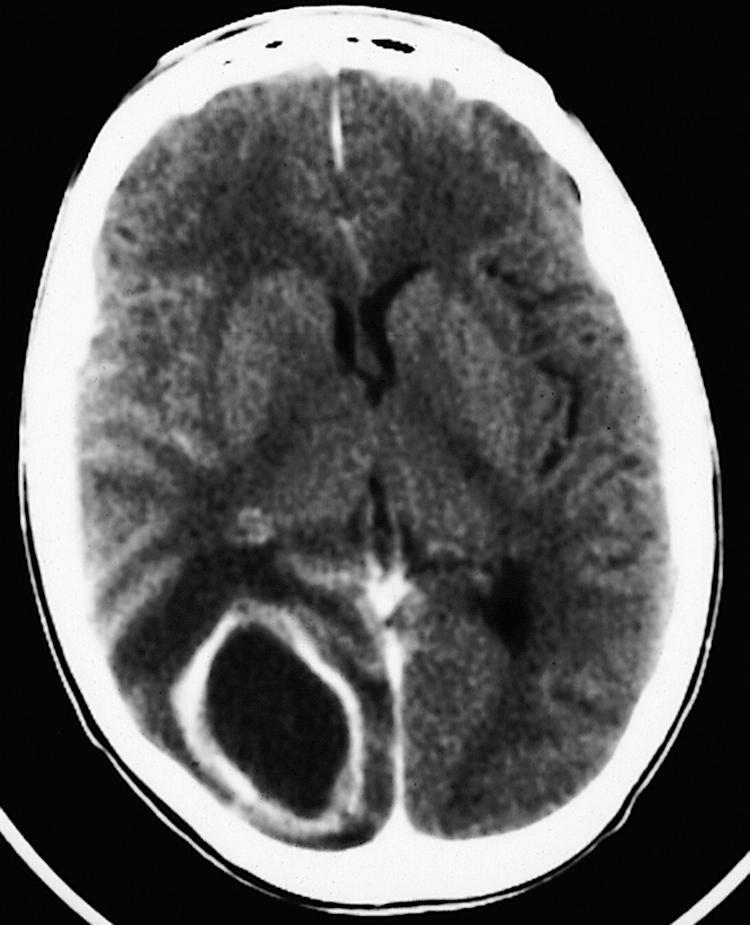
Spinal epidural hematomas are very rare but may occur in certain subpopulations of patients undergoing lumbar puncture. Those most at risk are individuals with a bleeding diathesis, including those treated with anticoagulants either before or immediately after lumbar puncture and those with abnormal clotting mechanisms, especially thrombocytopenia. The condition occurs, but rarely, even with an atraumatic tap and in the absence of a coagulation defect. Spinal subdural hematomas after lumbar puncture are even rarer. Lumbar puncture can injure the dural or arachnoid vessels, which may result in minor hemorrhage into the CSF. This is generally of little consequence. However, the number of patients with hemophilia and human immunodeficiency virus (HIV) infection who require lumbar puncture has increased since the late 1990s. In a coagulopathic patient, attempt to correct the clotting deficiency if clinically feasible and time permits. The procedure should be performed by experienced clinicians, who are less likely to traumatize the dura. After the procedure, monitor the patient carefully for progressive back pain, lower extremity motor and sensory deficits, and sphincter impairment. Thoroughly investigate any complaints of motor weakness, sensory loss, or incontinence after lumbar puncture. Lumbar puncture may be performed in patients with a coagulation defect if the procedure is expected to provide essential information, such as in the diagnosis of meningitis and the pathogen responsible. Correct warfarin-induced coagulopathy with fresh frozen plasma (FFP) or prothrombin complex concentrate together with vitamin K. The vitamin K–FFP protocol might need 12 to 24 hours to totally reverse the effect of warfarin. Correct the coagulopathy before a puncture if the clinical situation permits such delay. Butler has described the off-label use of low-dose prothrombin complex concentrate for the correction of warfarin-induced coagulopathy prior to lumbar puncture. Lumbar puncture can be performed safely in patients with hemophilia A or B whose deficient clotting factor is replenished before the procedure. Additional replacement of the clotting factor after the procedure is of unknown value.
Performance of lumbar puncture in patients with leukemia and low platelet counts has also been studied. Howard and coworkers reported on 5223 lumbar punctures performed on 958 children with newly diagnosed acute lymphoblastic leukemia. The platelet count was 10 × 10 9 /L or lower in 29 children, 11 to 20 × 10 9 /L in 170 children, and 21 to 50 × 10 9 /L in 742 children. No serious complications were reported in any group. The overall rate of traumatic taps was 10.5%, but such taps were not associated with adverse sequelae. The authors concluded that in children with acute lymphoblastic leukemia, prophylactic platelet transfusion for lumbar puncture is not required if the platelet count is higher than 10 × 10 9 /L. The number of patients with platelet counts lower than 10 × 10 9 /L was too small to allow any conclusion about this group. A more recent review (2010) concluded that in the absence of additional risk factors, a platelet count of 40 × 10 9 /L is “safe” for lumbar puncture. Lower counts are probably safe as well, but there was insufficient evidence to make recommendations. The 2015 clinical guidelines from the AABB (formerly the American Association of Blood Banks) include a weak recommendation for prophylactic platelet transfusion for patients having elective diagnostic lumbar puncture with a platelet count less than 50 × 10 9 /L, acknowledging that the position was based on very-low-quality evidence.
Aspirin and nonsteroidal antiinflammatory agents have not been shown to increase the risk for bleeding following lumbar puncture. Subcutaneous heparin administration is not believed to pose a substantial risk for bleeding after lumbar puncture if the total daily dose is less than 10,000 units. The risk for bleeding in patients taking clopidogrel, ticlopidine, or a glycoprotein (GP) IIb/IIIa receptor antagonist is not known but is probably small; however, use of these agents should cause the clinician to proceed with caution. One scenario is the need to diagnose meningitis because of an unusual or difficult-to-treat pathogen. It is necessary to withhold clopidogrel and ticlopidine 1 to 2 weeks before their anticoagulant effect has fully dissipated, making the decision for emergency lumbar puncture in such patients a risk-benefit scenario, with no firm guidelines. Pharmacologic data suggest that cessation of the GP IIb/IIIa receptor antagonist tirofiban may allow lumbar puncture after 8 hours and cessation of abciximab after 24 to 48 hours. Spinal hematoma may develop in 1% to 2% of patients who receive full anticoagulant therapy after undergoing lumbar puncture.
Proceed with caution in a patient with prior lumbar fusion or laminectomy. It is technically difficult to enter the subarachnoid space in the presence of significant postoperative changes. It would be acceptable to perform the puncture in an applicable space above or below the surgical scar; otherwise, opting for fluoroscopic guidance is prudent.
Attempts have been made to link bacterial meningitis to a lumbar puncture procedure in a bacteremic patient. Presumably, the procedure introduces bacteria into the CSF. This phenomenon is rare, difficult to substantiate, and not supported by clinical data. Though of theoretical concern, bacteremia should not be used as a criterion to forego lumbar puncture if meningitis is suspected.
If the history and physical examination suggest a treatable illness such as meningitis or SAH, the clinician may perform a spinal puncture after careful consideration of the entire clinical picture. In all cases, undertake the study after careful thought regarding how the results will contribute to the evaluation and treatment of the patient. It is unlikely that spinal puncture will beneficially alter management in patients with neoplastic disease, intracranial hematoma, abscess, a completed nonembolic infarction, or cranial trauma. Moreover, even when acute life-threatening emergencies such as SAH or meningitis are suspected, delaying CSF examination temporarily while empirical treatment proceeds is an important management option when there are concerns about the safety of the procedure.
Assemble the standard equipment for a spinal puncture before starting the procedure. Place it where the operator can easily access it. A standard-point Quincke cutting needle is most often used and supplied with the kit. Some operators prefer to use a Sprotte needle (Havel's, Inc., Cincinnati, OH) or a Whitacre needle (Becton Dickinson and Company, Rutherford, NJ) to minimize any dural injury associated with passage of the needle ( Fig. 60.2 ). These styletted needles have a side port for withdrawal of fluid and, theoretically, are more likely to separate than cut the dural tissue. Although commercial kits provide most of the items needed for lumbar puncture, the operator should bring additional supplies, including supplemental spinal needles, specimen tubes, gauze, antiseptic solution, additional local anesthetic, needles and syringes, and extra sterile gloves of the appropriate size (see Review Box 60.1 ).
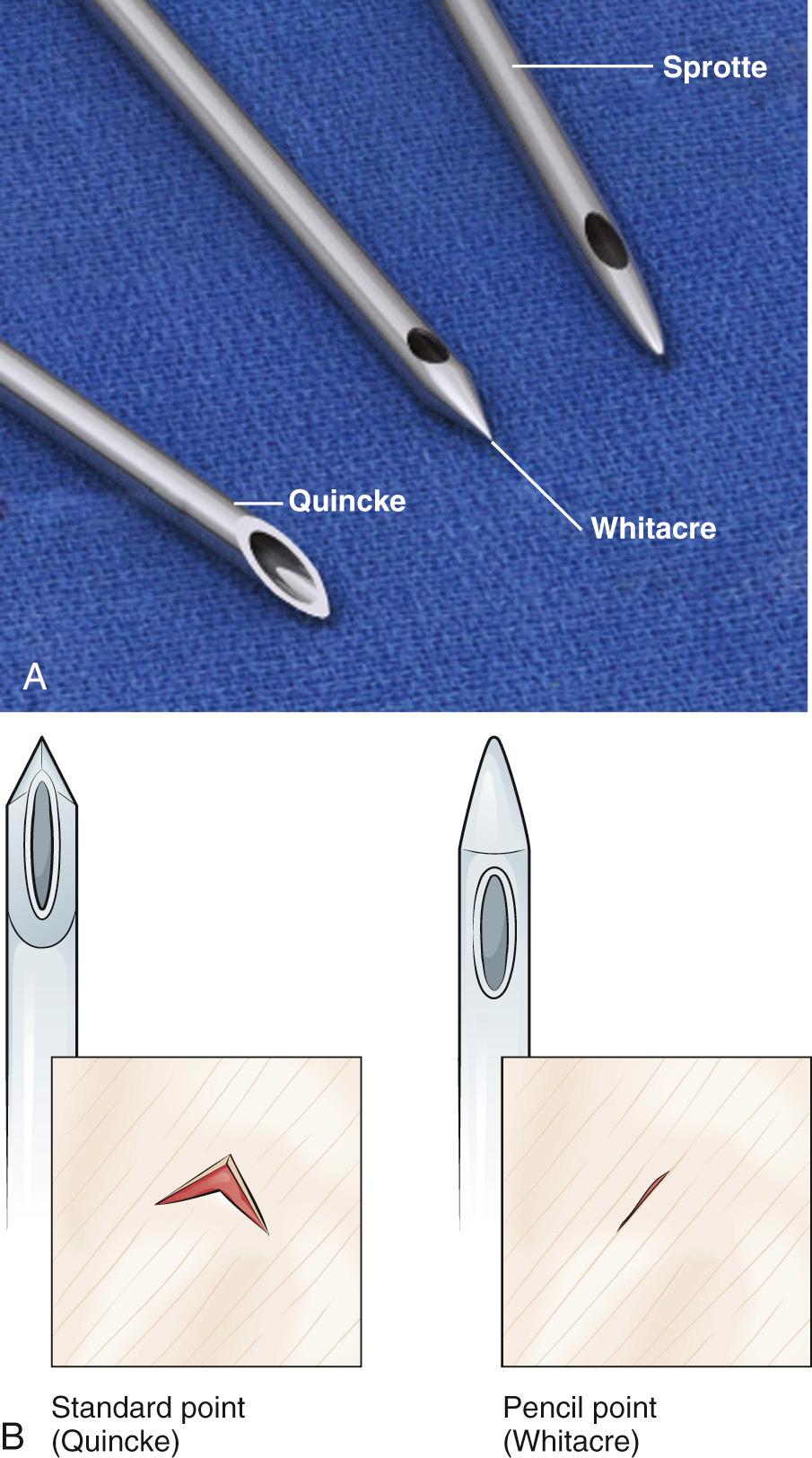
Lumbar puncture ( and ) is commonly carried out with the patient in the lateral recumbent position ( Fig. 60.3 ). A line connecting the posterior superior iliac crests intersects the midline at approximately the L4 spinous process ( Fig. 60.4 ). Spinal needles entering the subarachnoid space at this point are well below the termination of the spinal cord, and the only important neurologic structure is the cauda equina. Generally, the needle pushes isolated nerves to the side during advancement. The adjacent interspace above or below may be used, depending on which area appears to be most accessible to palpation. The space between the lumbar vertebrae is relatively wide. In the thoracic region, the spinous processes overlap and are directed caudally; therefore there is no midline area free of overlying bone. In adults, the spinal cord extends to the lower level of L1 or the body of L2 in 31% of persons, thus eliminating higher levels as sites for puncture. Puncture in adults and older children may be performed from the L2-L3 interspace to the L5-S1 interspace.
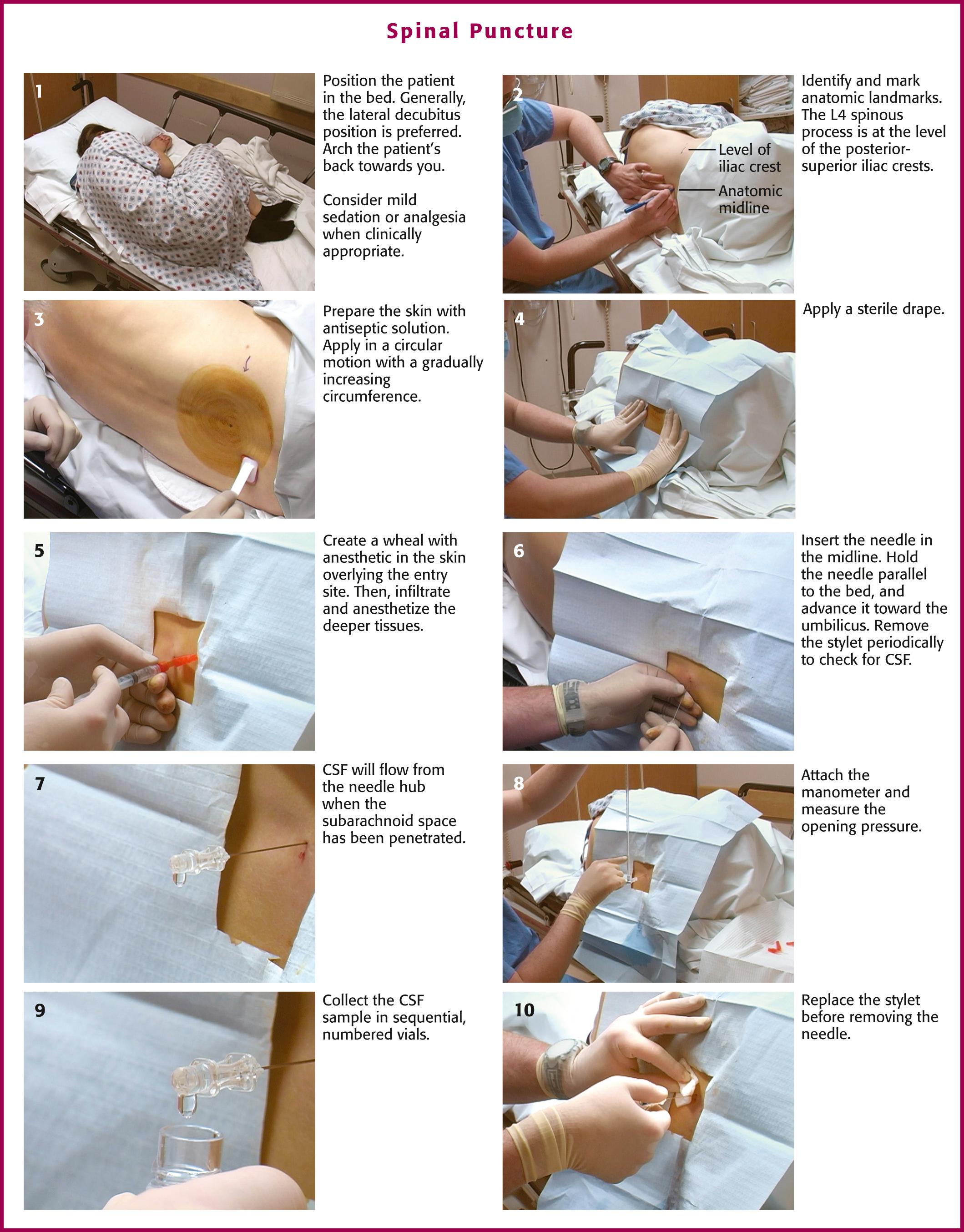
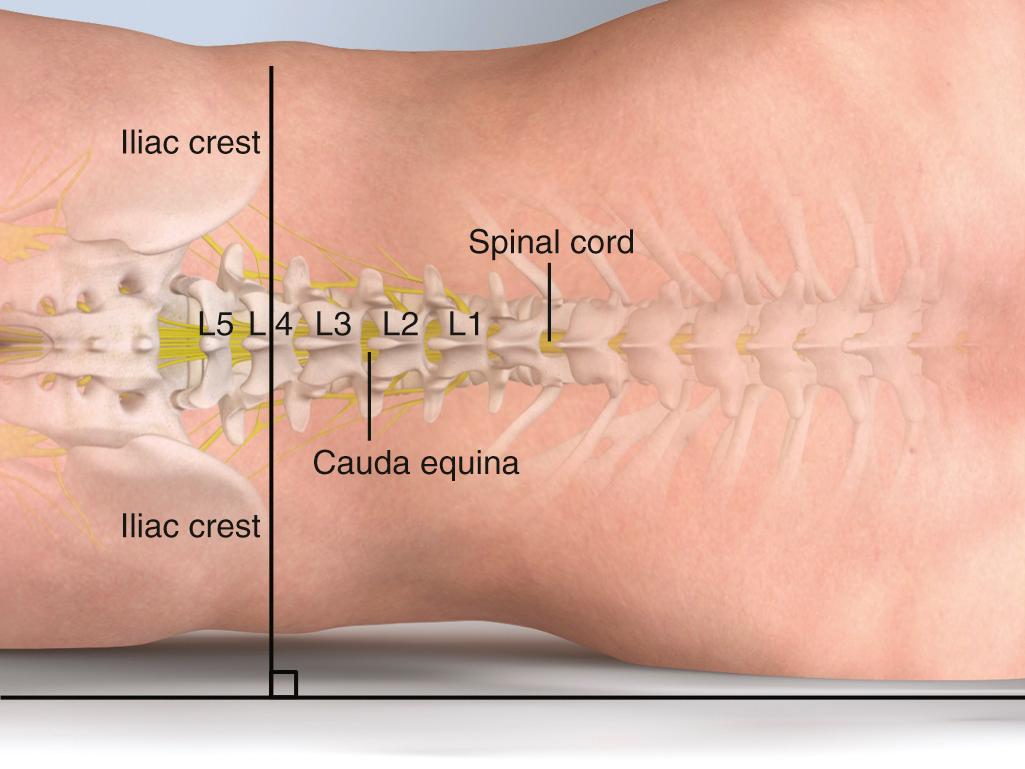
Developmentally, the spinal canal and the spinal cord are of equal length in the fetus. Growth of the cord does not keep pace with the longitudinal growth of the spinal canal. At birth, the cord ends at the level of the L3 vertebra. Consequently, in infants the needle should be placed at the L4-L5 or L5-S1 interspace. The subarachnoid space extends to the S2 vertebral level; however, the overlying bony mass prevents entry into this lowermost portion of the subarachnoid space.
When performed with parenteral sedation and proper local anesthesia, a spinal tap is neither overly distressing nor very painful to most patients. Almost all patients are likely to have some anxiety about a spinal puncture for several reasons, including the stories commonly told of severe complications. Explain the procedure in advance and discuss each step during the course of the test to reduce the patient's anxiety. Inquire about any history of allergies to local anesthetic agents and topical antiseptics. Obtain written informed consent whenever possible. In all cases, include a detailed procedural note that documents the process of patient or guardian education regarding the indications, procedural techniques, risks and benefits, alternatives to the procedure, and the patient's or guardian's consent for the procedure. Abridge this step when the patient is critically ill or eliminate it when the patient is mentally incapacitated and no guardian is present. Many patients greatly fear lumbar puncture, and hence some clinicians provide routine preprocedure sedation or analgesia if not clinically contraindicated. Intravenous midazolam and fentanyl are useful adjuncts, but practices vary and there is no consensus on standards with regard to the use or nonuse of preprocedure medications. If the patient is anxious, it is reasonable to give a benzodiazepine agent parenterally (e.g., midazolam, 0.1 to 2.5 mg intravenously for a healthy adult younger than 60 years of age) to facilitate the procedure. Fentanyl at a dose of 0.5 to 1.5 µg/kg (adults) is a reasonable alternative.
The next important step is positioning the patient. Generally, place older children and adults in the lateral decubitus position for the procedure. Give the patient a pillow to keep the head in line with the vertebral axis. Position the shoulders and hips perpendicular to the stretcher or table. Use a firm table or bed when available. Because flexion of the neck does not facilitate the procedure to any great extent and severe flexion may add to the patient's discomfort, this step may be omitted. Severe flexion of the neck in an infant may cause airway compromise. Arch the lower part of the patient's back toward the clinician by having the patient's knees drawn toward the chest.
Some clinicians place the patient in an upright sitting position because the midline is more easily identified. This position can be used in both adults and infants ( Fig. 60.5 ). The higher CSF hydrostatic pressure while sitting may aid flow of CSF in a dehydrated patient. Observe caution regarding orthostatic changes in blood pressure and airway maintenance. Generally, allow a sitting patient to lean onto a bedside stand and use a pillow to rest the head and arms. Have an assistant support the patient during the procedure. Radiographic studies by Fisher and colleagues have demonstrated the advantages of hip flexion when the sitting position is used. To accomplish hip flexion, use a stool to support the patient's feet, which pulls the knees up toward the chest. This increases lumbar interspinous width, which may increase the success and ease of needle passage.
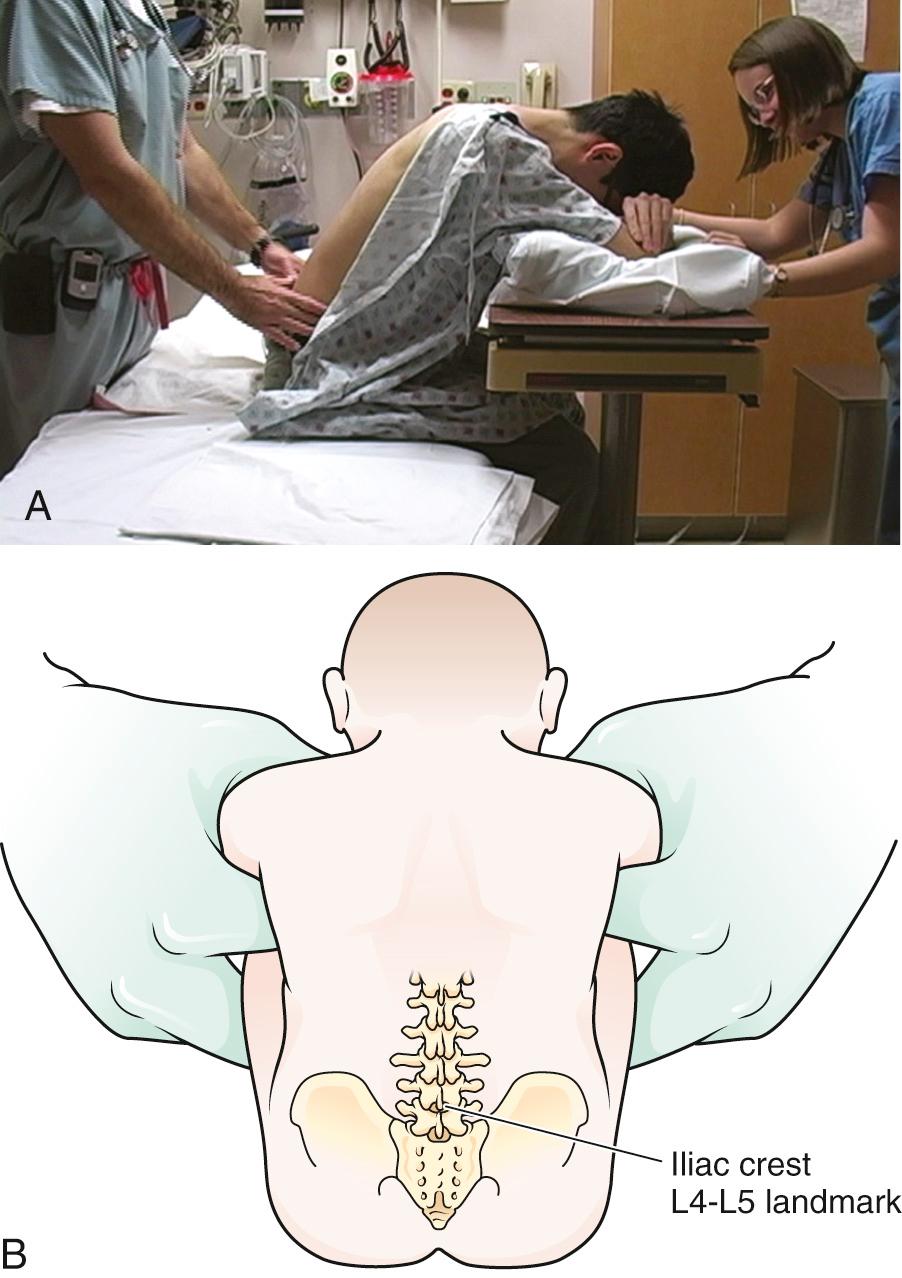
Iatrogenic infection after lumbar puncture is extremely rare. Use sterile gloves during the procedure; the need for face masks is debatable. Some authors have suggested applying the same guidelines for control of central line infection (caps, gowns, gloves, and masks) to lumbar puncture. Wash the patient's back with an antiseptic solution applied in a circular motion and increase the circumference of the cleansed area with each motion. Place a sterile towel or drape between the patient's hip and the bed. Commercial trays have a second sterile drape with a hole that may be centered over the site selected for the procedure.
Infiltrate the skin and deeper subcutaneous tissue generously with local anesthetic. Buffered or warmed 1% lidocaine is preferred. Warn the patient about transient discomfort from the anesthetic. Anesthetizing the deeper subcutaneous tissue significantly reduces procedural discomfort. Merely raising a skin wheal is insufficient anesthesia. Some operators not only anesthetize the interspinous ligament but also apply local anesthetic in a vertically fanning distribution on both sides of the spinous processes near the lamina. Such a field block on each side of the spinous processes anesthetizes the recurrent spinal nerves that innervate the interspinous ligaments and muscles.
While waiting for the anesthetic to take effect, connect the stopcock and manometer and ensure that the valve is working. Commonly, a 3.5-inch, 20-gauge needle is used in adults, and a 2.5-inch, 22-gauge needle is used in children (a 1.5-inch, 22-gauge needle is available for infants). Needles of these sizes have enough rigidity to allow the procedure to be accomplished easily but make less of a dural tear than larger needles do. Patients should be told to report any pain and should be informed that they will feel some pressure.
With the patient in the lateral decubitus position, place the needle into the skin in the midline, parallel to the bed. Hold the needle between both thumbs and index fingers ( Fig. 60.6 ). After the subcutaneous tissue has been penetrated, angle the needle toward the umbilicus. The bevel of the needle should be facing straight up toward the ceiling. The supraspinal ligament connects the spinous processes, and the interspinal ligaments join the inferior and superior borders of adjacent spinous processes. The ligamentum flavum is a strong, elastic membrane that may reach a thickness of 1 cm in the lumbar region. The ligamentum flavum covers the interlaminar space between the vertebrae and assists the paraspinous muscles in maintaining an upright posture ( Fig. 60.7 ). The ligaments are stretched in a flexed position and are more easily crossed by the needle. The ligaments offer resistance to the needle, and a “pop” is often felt as they are penetrated. Some clinicians choose to advance the needle in small increments, removing the stylet to check for CSF flow. If no fluid flows, the stylet is replaced and the needle is advanced. Hold the stylet in place during advancement, until the subarachnoid space has been reached. The pop may not be felt with the very sharp needles contained in disposable trays.
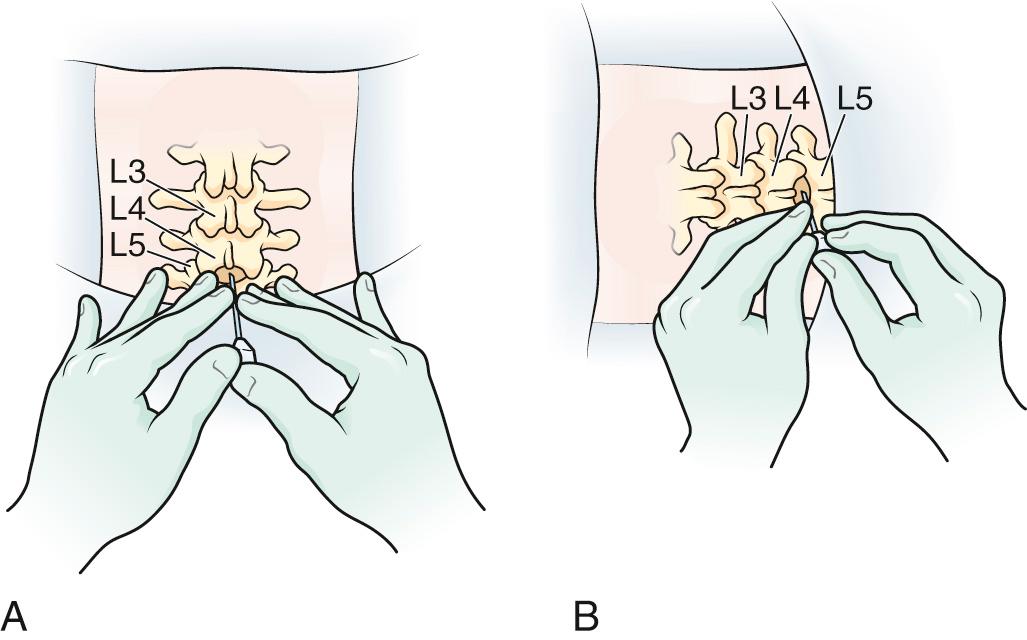
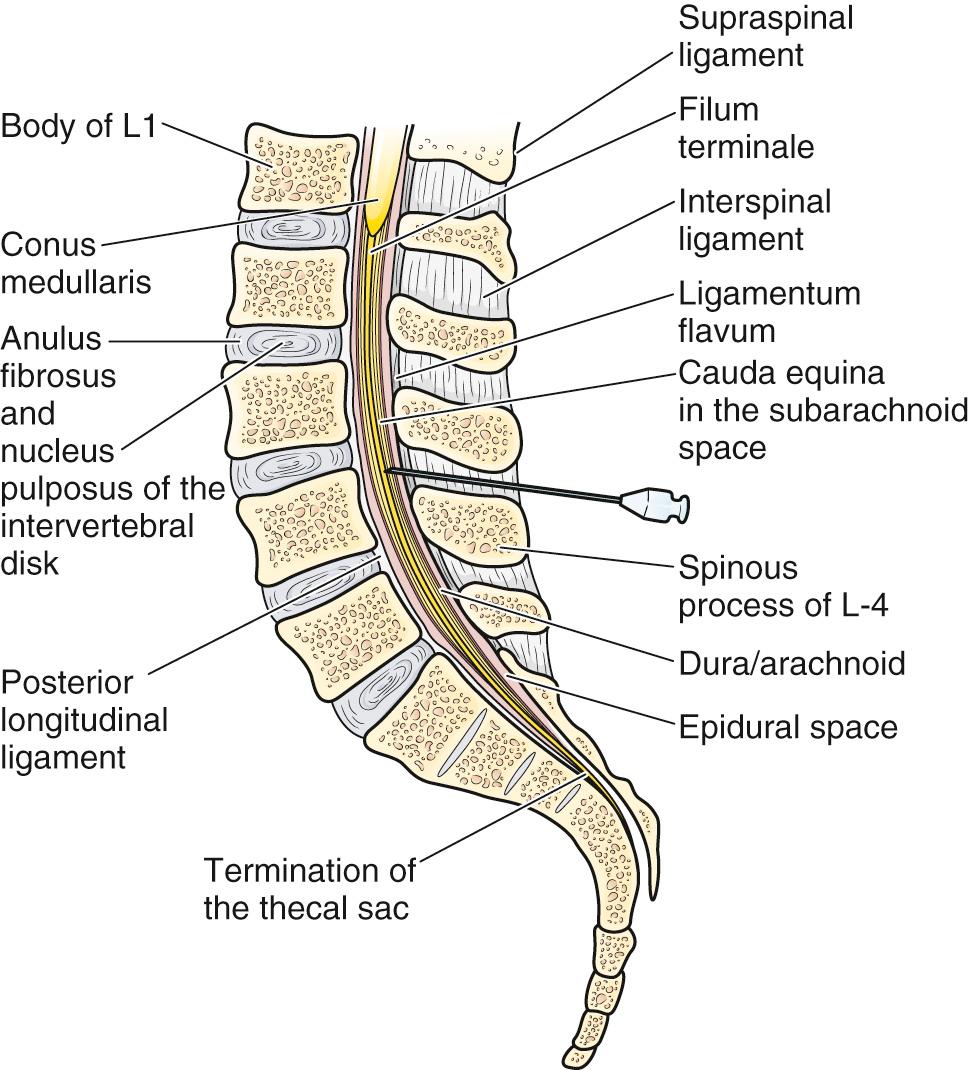
If bone is encountered, partially withdraw the needle to subcutaneous tissue. Repalpate the back and ascertain that the needle is in the midline. Directing the tip of the needle toward the navel often enhances navigation of the interspinal space. If bone is encountered again, slightly withdraw and reangle the needle so that the point is placed at a more sharply cephalad angle ( Fig. 60.8 ). This approach should avoid the inferior spinous process.
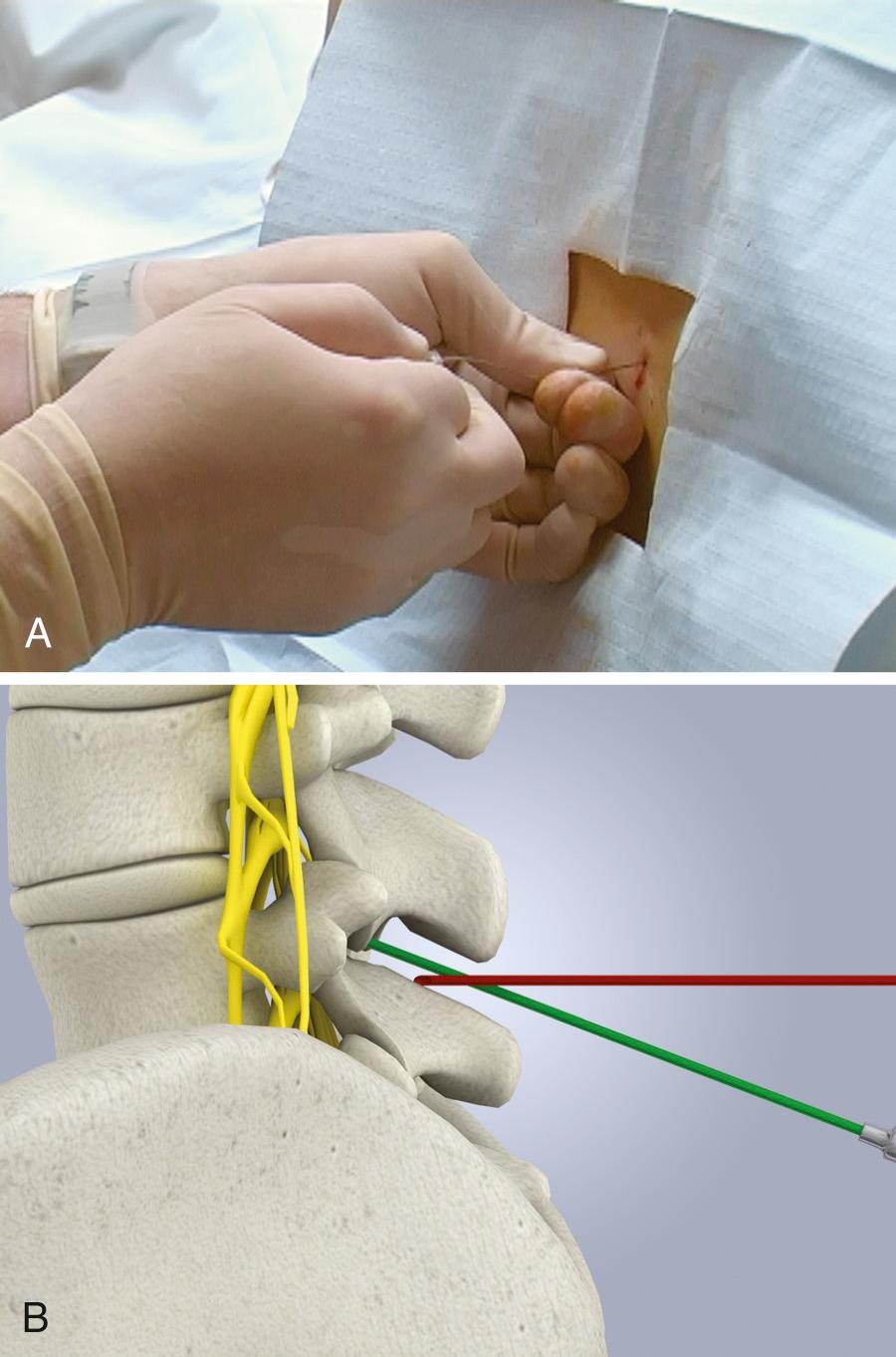
Normal CSF is a clear fluid and will flow from the needle when the subarachnoid space has been penetrated and the stylet is removed. In normal patients, the dura will be penetrated when the needle is advanced approximately one-half to three-fourths of its length. In obese patients, the entire length of the needle may be required to reach the subdural space ( Fig. 60.9 ).
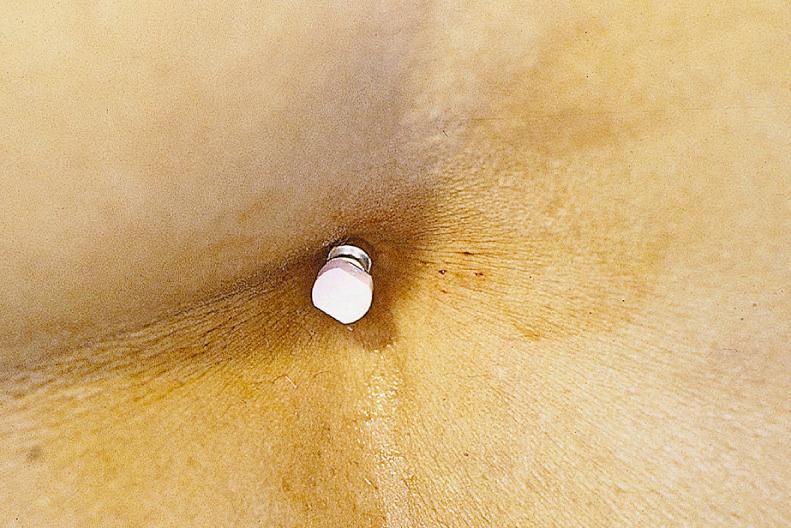
If feasible, attach the manometer and record the opening pressure ( Fig. 60.10 ). This step is commonly omitted in critically ill patients. Pressure readings from a struggling patient may be inaccurate. Readings are valid only if taken with the patient relaxed and in the lateral decubitus position (not the sitting position). A three-way stopcock, supplied in disposable trays, allows both collection of CSF and measurement of opening pressure with a single needle. Positioning of the manometer is often more convenient if an extension tube (provided with most disposable trays) connects the needle hub to the stopcock, which in turn is attached to the manometer. Position the manometer so that the “zero” mark is at the level of the spinal needle. Then ask the patient to relax. Changing position from a straight to a fully extended position increases CSF pressure minimally, by 2 to 8 cm of water. Extending the legs after needle placement does not meaningfully decrease opening CSF pressure. CSF flow is enhanced if the patient straightens or extends the legs following confirmation of proper needle position. The observation of phasic changes in the fluid column with respirations and arterial pulsations confirms needle placement in the subarachnoid space. If the needle is against a nerve root or is only partially within the dura, the pressure may be falsely low, and respiratory excursions will not be reflected in the manometer. Minor rotation of the needle may solve these problems. Hyperventilation will reduce the pressure readings because of hypocapnia and the resultant cerebral vasoconstriction.
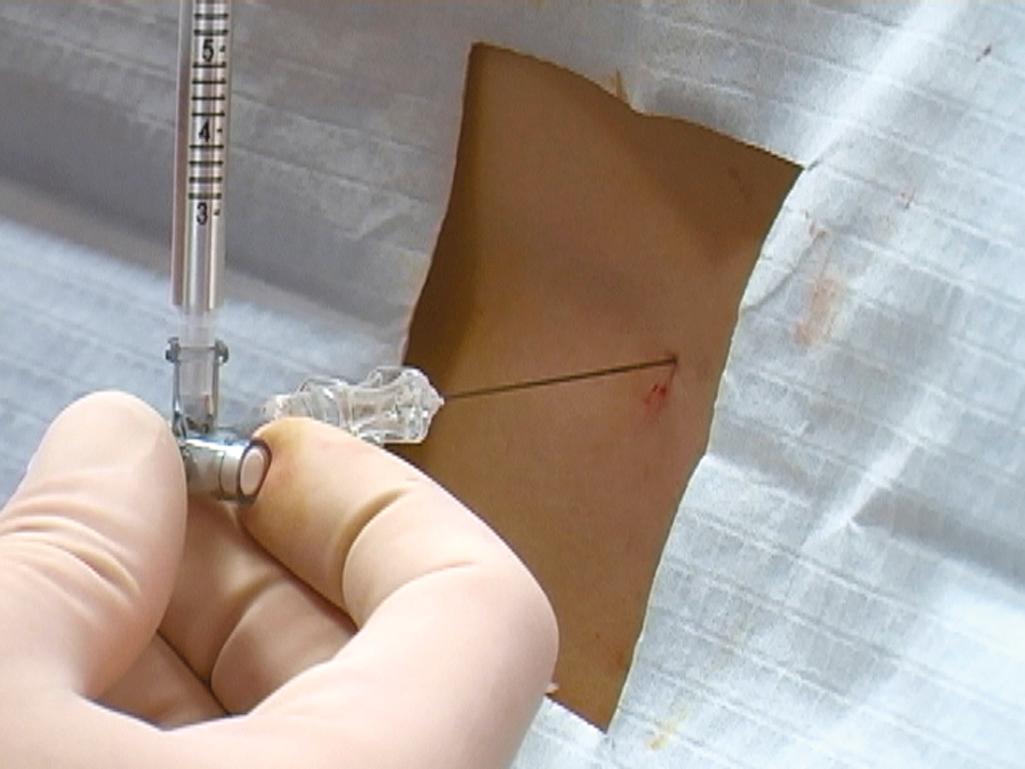
After measuring the pressure, turn the stopcock and collect enough fluid to perform all the studies desired. It is generally advised that CSF should be collected by a free flow from the needle, and not by aspiration. The first sample of fluid exits from the manometer if pressure has been measured, and then additional fluid flows from the spinal canal. Even if the pressure is elevated, remove sufficient fluid for performance of all indicated studies because the risk associated with the procedure involves the dural rent, not only the amount of fluid initially removed. Presumably, more fluid will subsequently be lost through the hole in the dura. Replace the stylet into the needle before withdrawing it.
Commercial trays generally supply four specimen tubes. One tube is commonly used for determining protein and glucose levels and for electrophoretic studies, another is used for microbiologic and cytologic studies, and a third is used for serologic tests. Cell counts should be performed in the first and third tubes to help differentiate traumatic taps from true SAH. Depending on the clinical scenario, additional tests may be indicated. Use special stains, such as India ink for suspected Cryptococcus infection in patients with acquired immunodeficiency syndrome (AIDS), acid-fast stain in patients with possible tuberculous meningitis, and viral studies in patients with suspected encephalitis. The fourth tube can be stored under refrigeration in the laboratory for any additional studies that may be required after the initial assessment.
Traumatic taps are common and usually clinically inconsequential. Nevertheless, they can be minimized by proper patient and needle positioning. A traumatic tap most commonly occurs when the subarachnoid space is transfixed at the entrance of the ventral epidural space, where the venous plexus is heavier. A plexus of veins forms a ring around the cord, and these veins may be entered if the needle is advanced too far ventrally or is directed laterally ( Fig. 60.11 ). If blood is encountered and the fluid does not clear, repeat the procedure at a higher interspace with a fresh needle. A traumatic tap, per se, is not a particularly dangerous problem in a patient with normal coagulation, and no specific precautions are needed if blood-tinged fluid is obtained. However, observe for signs of cord or spinal nerve compression from a hematoma developing within the first several hours in patients with a coagulopathy.
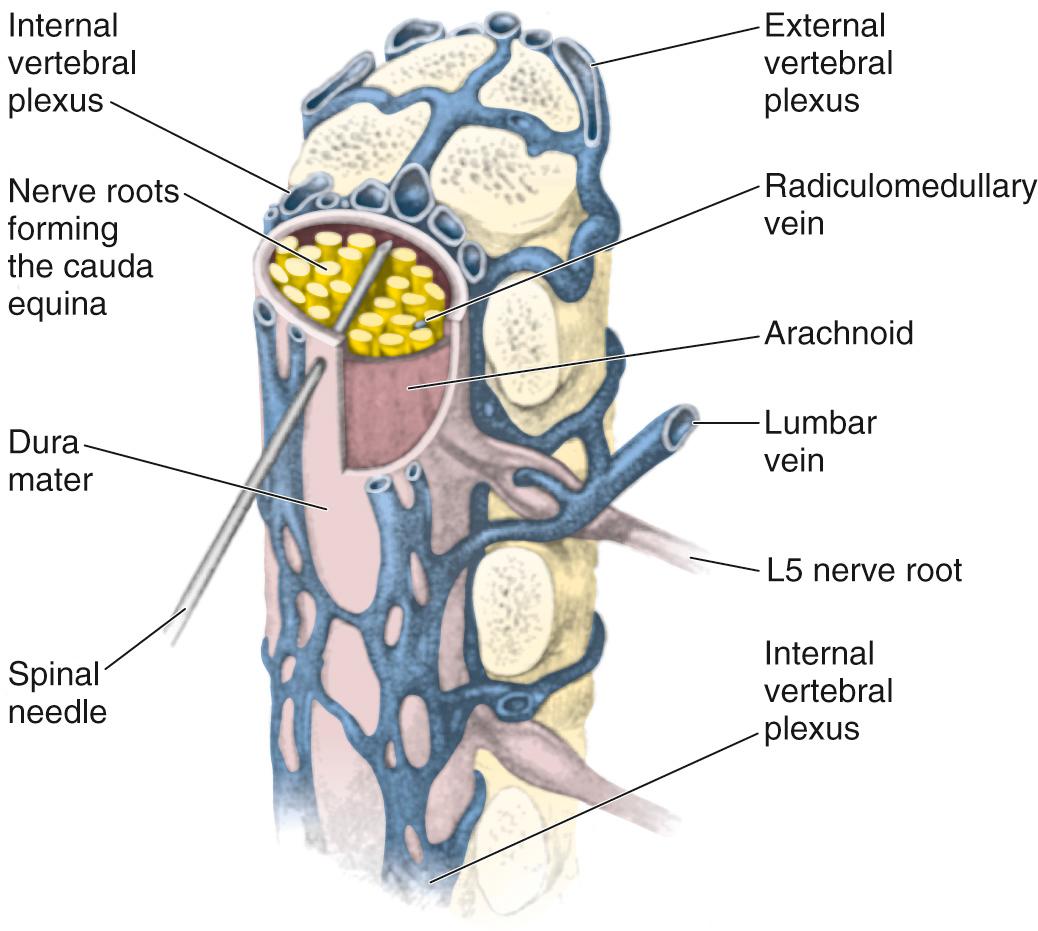
The supraspinal ligament might be calcified in older persons, making a midline perforation difficult. A calcified ligament may deflect the needle. In this case, use a slightly lateral approach. Because the lower lamina rises upward from the midline, direct the needle slightly cephalad to miss the lamina and slightly medially to compensate for the lateral approach. The needle passes through the skin, superficial fascia, fat, the dense posterior layer of the thoracolumbar fascia, and the erector spinae muscles. The needle then penetrates the ligamentum flavum (bypassing the supraspinal and interspinal ligaments), the epidural space, and the dura before CSF is obtained ( Fig. 60.12 ). Lateral cervical puncture is an alternative approach that can be performed utilizing an insertion site 1 cm inferior and 1 cm dorsal to the mastoid process.
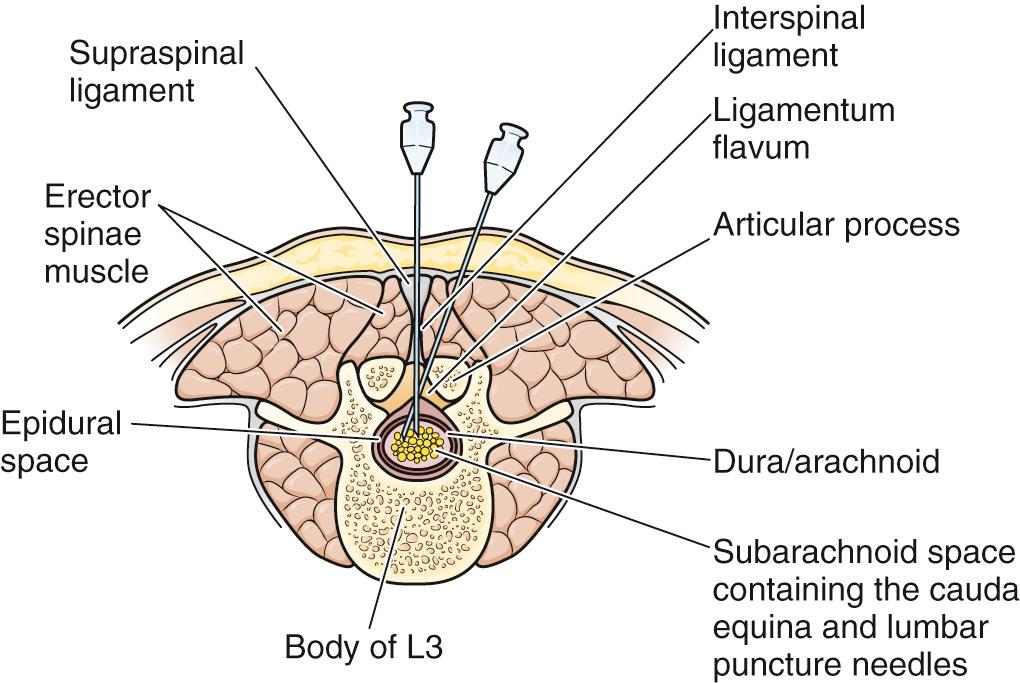
Lumbar puncture in infants is usually performed to exclude meningitis or encephalitis. The sitting position may allow the midline to be identified more easily. Use of a needle without a stylet has been suggested for small infants because this device allows the pressure to be estimated as the needle punctures the dura. However, failure to use a stylet may cause the subsequent development of an intraspinal epidermoid tumor. Use of a butterfly infusion set needle simplifies the procedure, which is helpful when managing a squirming or hyperactive patient. In general, a stylet is recommended primarily at the time of skin penetration and on needle withdrawal, although many operators use the stylet during any advancement of the needle.
If the child's neck is very tightly flexed, CSF might not be obtained. However, if the head is held in midflexion, CSF usually flows briskly. If CSF fails to flow, gently suction with a 1.0-mL syringe to exclude a low-pressure syndrome. Because pressure readings are inaccurate in a struggling child, measurement of pressure is not commonly attempted in infants and young children.
Avoid prolonged severe flexion of the neck in an infant because it may produce dangerous airway obstruction. If the infant suddenly stops crying, check the airway immediately. Proper positioning is best accomplished by an assistant, who maintains the spine maximally flexed by partially overlying the child and using the chest and body weight to immobilize the thorax and hips while holding the child behind the shoulders and knees. Infants have poor neck control; therefore the assistant must also ensure that the child maintains an open airway. Pay particular attention to avoiding marked neck and trunk flexion. Incorrect positioning usually results in multiple punctures and a bloody tap.
Newborn and preterm infants may experience significant hypoxia and clinical deterioration during lumbar puncture; a sitting position appears to be preferable. Lumbar puncture in infants with respiratory distress syndrome may pose greater risk than benefit. This is a problem primarily in neonates but may also apply to younger infants with sepsis. Closely monitor all infants with serious cardiopulmonary disease during the procedure. Preoxygenation with or without monitoring oxygen saturation may be used as a precaution.
Although local anesthesia or sedation has not been a routine practice during lumbar puncture in an infant or child, it is being reconsidered. Neonates perceive pain, and local anesthesia neither produces physiologic instability nor makes the procedure more difficult. The use of topically applied eutectic mixture of local anesthetics (EMLA) (AstraZeneca, Cambridge, United Kingdom) reduces the pain associated with needle insertion in newborns. Sedation of an anxious child may be considered, but sedatives are relatively contraindicated in an obtunded patient without a protected airway and in the setting of hemodynamic instability.
The traditional approach to lumbar puncture depends on palpation of bony landmarks to determine the correct location for insertion of the needle. However, landmarks are difficult to palpate in overweight and obese patients. When lumbar puncture fails, the usual alternative has been fluoroscopic guidance, which necessitates movement of the patient out of the ED, as well as the availability of an appropriately trained radiologist. Brook found CT guidance to be comparable to fluoroscopy in the facilitation of lumbar puncture in obese patients with a previously unsuccessful attempt. Bedside ultrasound is being used increasingly in emergency and critical care medicine, and its scope of practice has expanded to include guidance for a number of procedures, including lumbar puncture (see Ultrasound Box ). Ultrasound can be used in adults as well as neonates and infants.
When ultrasound is used to guide lumbar puncture, it is generally done in a static manner: the ultrasound probe is used to determine the site of skin entry, the skin is marked, and the probe is then set aside.
A linear probe is preferred, although for patients with an extremely high body mass index, a curvilinear probe may be required because of the distance between the skin and the spine.
The bony spinous process will appear as a hyperechoic crescent-shaped structure with posterior acoustic shadowing. In the transverse view, acquisition of a perfectly symmetric image will provide assurance that the probe is in the anatomic midline ( Fig. 60.US1 ). In the longitudinal view, multiple spinous processes can be visualized, along with the interspaces between them ( Fig. 60.US2 ).
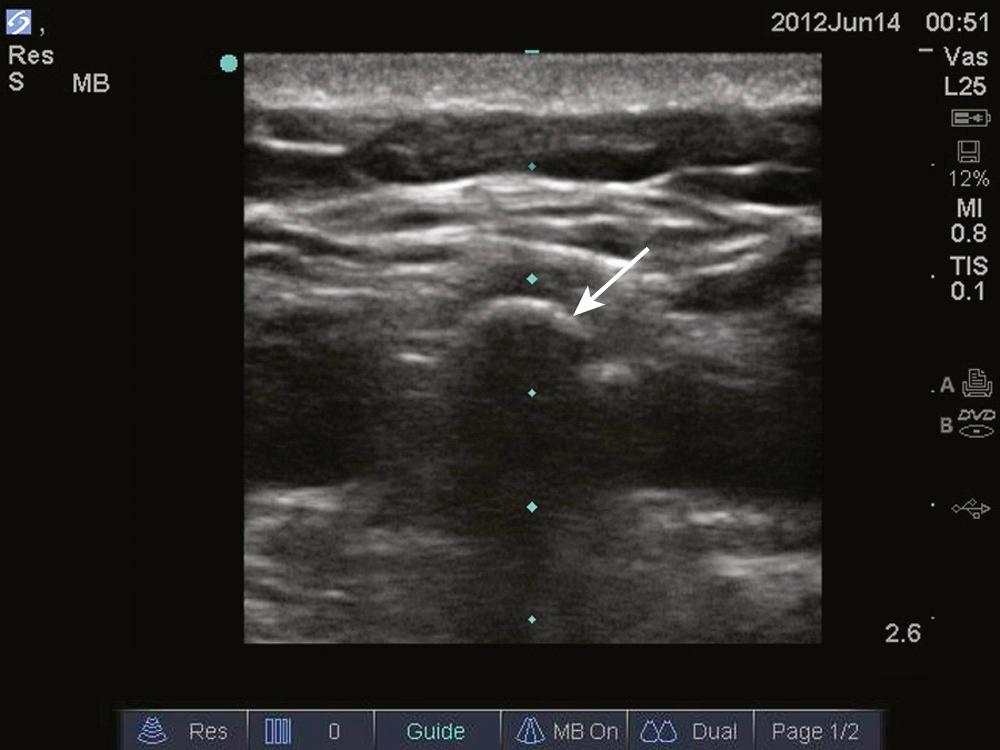
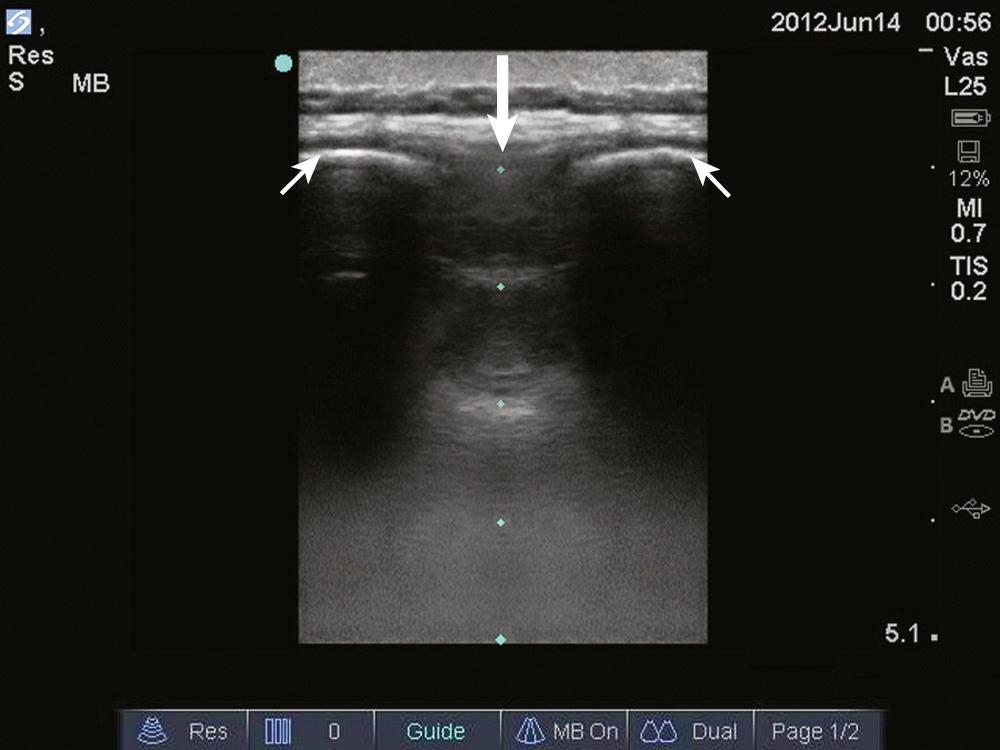
To perform ultrasound-guided lumbar puncture, position the patient in the usual manner. Place the ultrasound probe over the spine in a transverse orientation at the level of the iliac crests such that the shadow caused by the spinous process is centered on the screen. Use a pen to mark the skin on each side of the transducer, exactly at the midpoints ( Fig. 60.US3 ). These two marks can then be connected to mark the midline of the spine. Next, rotate the transducer 90 degrees to obtain a midline longitudinal view and position it until the gap between two spinal processes is in the center of the screen. Mark the skin at the midpoint of each side of the transducer and then connect the marks to form a single line ( Fig. 60.US4 ). The intersection of the two lines is the site for entry of the needle ( Fig. 60.US5 ). Cleanse the skin with antiseptic solution and perform the remainder of the procedure in the usual fashion.
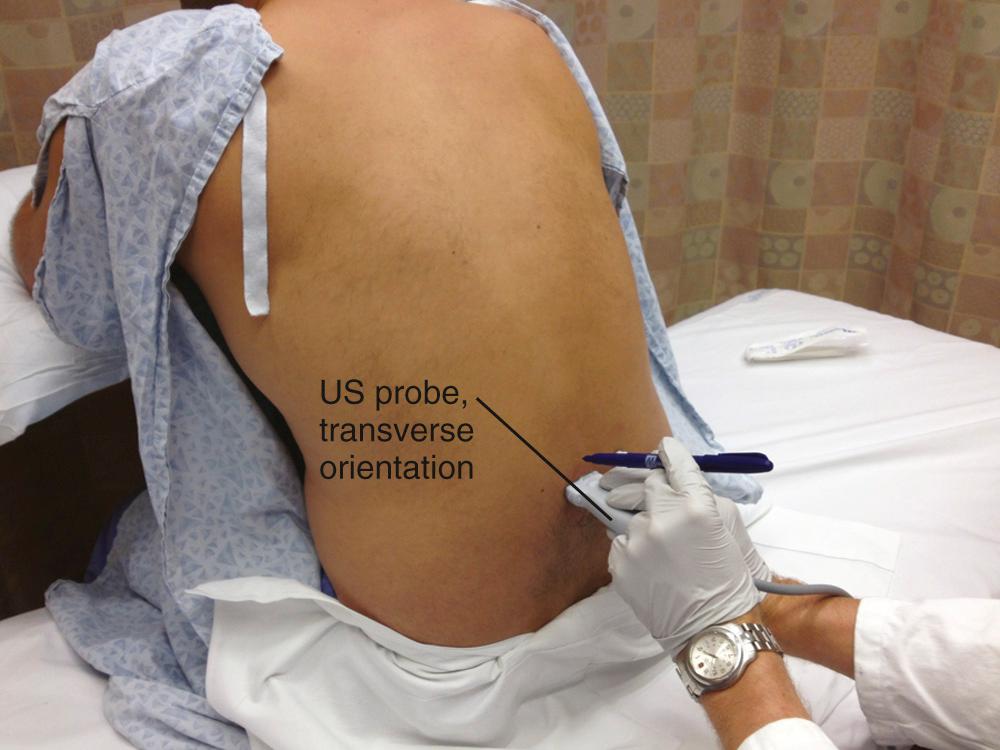
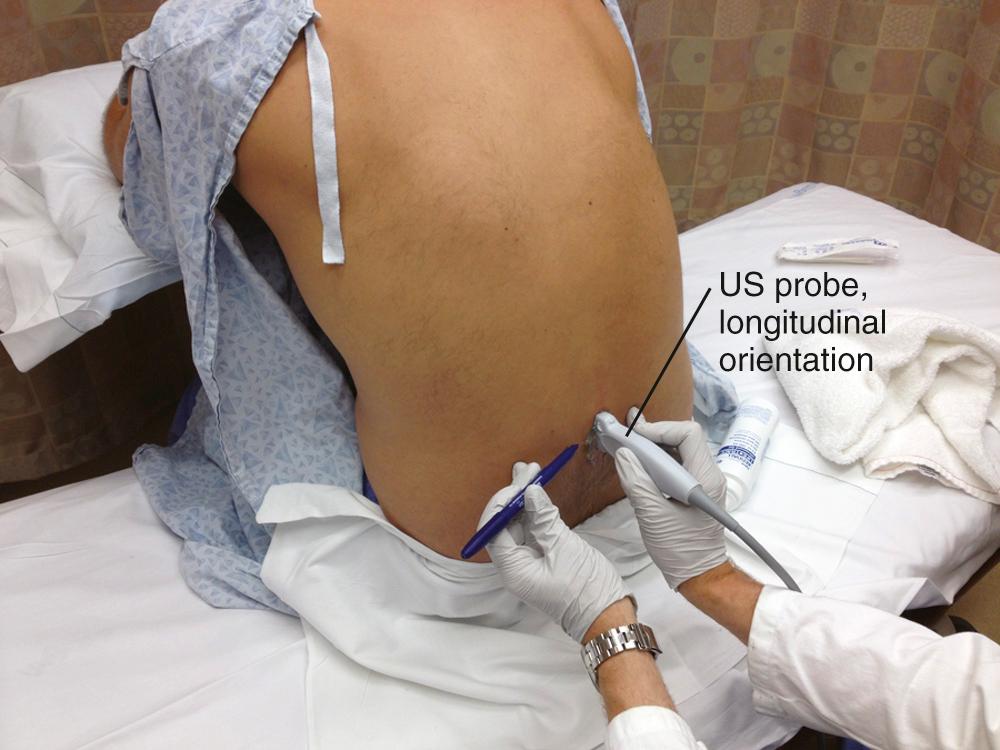
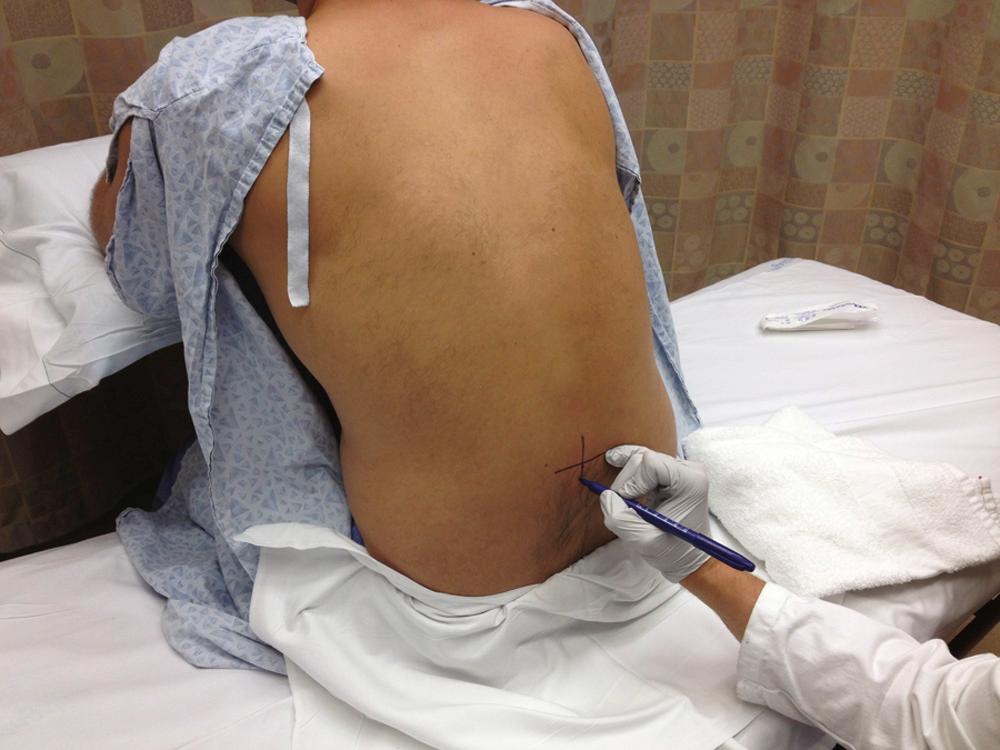
Become a Clinical Tree membership for Full access and enjoy Unlimited articles
If you are a member. Log in here